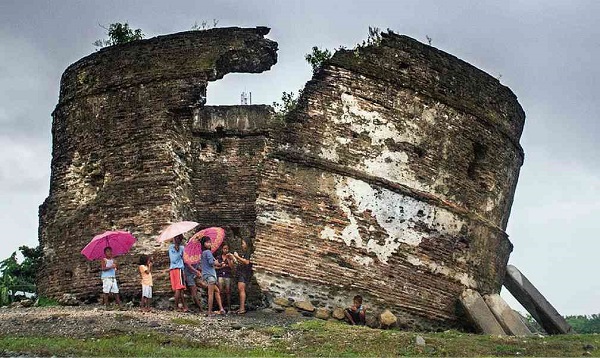
THE SPANISH-ERA “baluarte” (watchtower) on the shore of Barangay Victoria in Luna, La Union, is getting much needed help from the government, the community and the private sector to save it from the elements. RICHARD BALONGLONG
The phrase “one degree” is a bit disturbing, ominous even, for residents of Luna town in La Union province, which is known for its beach of colorful stones and the “baluarte” (watchtower).
Just a degree more of tilting and the baluarte, built during the Spanish era and which put the town on the tourism map, would collapse.
This was the finding of AMH Philippines Inc., the engineering consultancy firm that conducted a feasibility study on the preservation of the town’s famous historical landmark facing the West Philippine Sea.
The baluarte is leaning at a 20-degree angle, a dangerous inclination for the centuries-old structure, said Egbert Abiad, AMH project manager, who presented the study to Luna officials and residents on Saturday.
The feasibility study is the first professional move to preserve the structure built on the scenic beach of Barangay Victoria, where stones of different colors and shapes are gathered and sold by residents. Like most Spanish structures, it is made of adobe and coral blocks held together by lime and egg whites.
The baluarte was a fortress or a structure used for defense. It was used by Spaniards to warn residents of pirates, according to historical accounts.
Imee Villalba, a civil engineering associate at AMH, said the accounts had not established the structure’s actual age, whether it is 400 or 150 years old.
Tourism trademark
But whatever the age, the baluarte reminds the town of its history and it must be saved, Mayor Victor Marvin Marron said.
“We have the watchtower which is the town’s tourism trademark. We do not want it to become a ‘washed out tower’ and lose this important heritage,” Marron said.
La Union Gov. Manuel Ortega said he was capitalizing on the participation of the community and the private sector in preserving the baluarte as a reminder of the majestic past of the province, and in protecting the stone-picking industry of the town and the environment.
How AMH, an academe-industry linked engineering consultancy firm based in the University of the Philippines in Diliman, Quezon City, came into the picture is a story in itself.
When La Union native Victoria Liban, a long-time resident of the United States, returned to the province, she saw the baluarte, fell in love with it, and wondered how it could be saved.
Liban told Ortega about a friend from way back, Dr. Victor Pulmano, an engineer who graduated from the UP but is now based in Australia. They contacted Pulmano who contacted AMH.
But baluarte’s grandeur won AMH over that it waived professional fees and conducted the feasibility study as part of the company’s corporate social responsibility project.
Band-aid solutions
It is a race against time and tide to save the baluarte. The structure would have collapsed more than 10 years ago, had it not for the intervention of the provincial engineering office, which propped it with piles (concrete columns used in building bridges) and covered its perimeter with gabion mattress in 2007.
The provincial agriculture office also prohibited the picking of stones 50 meters around the baluarte to check erosion.
But all that were done were “band-aid solutions.”
If left on its own, the baluarte would tilt by one more degree after a strong typhoon, AMH engineers said. They recommended more permanent solutions to preserve the structure as it is—split in the middle, with each side precariously leaning.
Geogy Vizcarra, AMH assistant engineer, said both split portions of the 5.6-meter high baluarte should be tilted 5 degrees inward. Then for structural stability, the bottom would be jet-grouted.
Abiad explained that jet grouting is the injection of cement slurry (a mixture of cement, sand and water), through high-pressure pumps, to fill spaces in the sand and stabilize the ground condition.
“We can’t do anything but accept that the structure is already tilted. Hopefully, we can make the tilting less or stop it from tilting more. [But] how long it will be preserved, assuming we can make it stand a little, we are not sure. If we can grout the bottom, that thing will still be standing there, it will be a tower standing on a rock,” he said.
If nothing is done, it will take only a big storm to destroy the baluarte as storm surges can reach up to 10 meters, towering over the structure already weakened by the elements, AMH engineers said.
What AMH did was only a feasibility study but the actual preservation falls on the shoulders of the local government and national agencies.
Former San Fernando Mayor Mary Jane Ortega, whose husband, Rep. Victor Ortega, represents La Union’s first district, said funds for the project could not be sourced from the Priority Development Assistance Fund (PDAF) or from agencies involved in preservation of historical buildings because the baluarte had not been listed as a historical landmark.
To enable government agencies to fund the preservation project, the Luna municipal council passed Resolution 68-2013, which requested the National Historical Commission of the Philippines to declare the watchtower a national historical landmark, and Resolution 69-2013, which asked the National Museum to declare it a national treasure.

